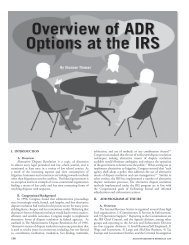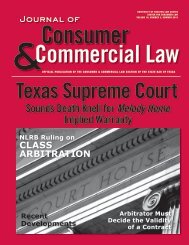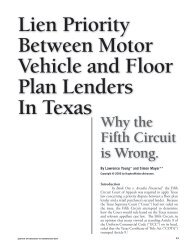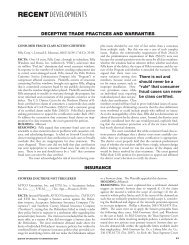Teaching Consumer Credit Law in an Evolving Australian Economy
Teaching Consumer Credit Law in an Evolving Australian Economy
Teaching Consumer Credit Law in an Evolving Australian Economy
Create successful ePaper yourself
Turn your PDF publications into a flip-book with our unique Google optimized e-Paper software.
RECENT DEVELOPMENTS<br />
<strong>in</strong> violation of §1692(g) of the FDCPA. Avila v. Rub<strong>in</strong>, 84 F.3d<br />
222, 226-27 (7th Cir. 1996). Under the unsophisticated consumer<br />
test, a debt collection letter must be clear <strong>an</strong>d comprehensible to<br />
a person who is un<strong>in</strong>formed, naïve, <strong>an</strong>d trust<strong>in</strong>g, but not without<br />
a rudimentary knowledge about the f<strong>in</strong><strong>an</strong>cial world or <strong>in</strong>capable<br />
of mak<strong>in</strong>g basic deductions <strong>an</strong>d <strong>in</strong>ferences. The st<strong>an</strong>dard also<br />
requires that a signific<strong>an</strong>t fraction of the population must f<strong>in</strong>d<br />
the letter confus<strong>in</strong>g <strong>in</strong> order for the letter to be <strong>in</strong> violation of<br />
the law.<br />
The court found that generally whether a debt collection<br />
letter is confus<strong>in</strong>g is a question of fact, but that a letter c<strong>an</strong> be<br />
found not confus<strong>in</strong>g as a matter of law if it is apparent from<br />
read<strong>in</strong>g the letter that a signific<strong>an</strong>t fraction of the population<br />
would be misled by it. Taylor v. Cavalry Inv., L.L.C., 365 F.3d<br />
572, 574 (7th Cir. 2004). The court stated that it had already<br />
ruled that l<strong>an</strong>guage that rushes the debtor to “act now” is merely<br />
“puffery” designed to create a mood rather th<strong>an</strong> to convey<br />
concrete <strong>in</strong>formation or mis<strong>in</strong>formation. The court held that<br />
the l<strong>an</strong>guage <strong>in</strong> the <strong>in</strong>st<strong>an</strong>t case did not violate §1692(g)(b),<br />
<strong>an</strong>d was only me<strong>an</strong>t to expedite action by the debtor. It did not<br />
specifically require immediate payment. Therefore, the l<strong>an</strong>guage<br />
of the letter did not contradict or overshadow Zemeckis’ right to<br />
a thirty-day validation period.<br />
COLLECTION LETTER DOES NOT VIOLATE FAIR<br />
DEBT COLLECTION PRACTICES ACT<br />
McMurray v. ProCollect, Inc., 687 F.3d 665 (5th Cir. 2012).<br />
FACTS: Defend<strong>an</strong>t ProCollect, a debt collector, mailed a<br />
letter to Pla<strong>in</strong>tiff J<strong>an</strong>et McMurray, attempt<strong>in</strong>g to collect a debt<br />
she allegedly owed to Highl<strong>an</strong>d Oaks Apartments. The letter<br />
expla<strong>in</strong>ed that her debt was referred to the collection agency <strong>an</strong>d<br />
“failure to timely validate the referenced amount due [would]<br />
cause” the debt collector to report the account to the credit<br />
report<strong>in</strong>g agencies. This particular section also expla<strong>in</strong>ed, <strong>in</strong><br />
all-caps, the negative ramifications that may result from fail<strong>in</strong>g<br />
to settle the debt. Below this <strong>in</strong>formation, the letter conta<strong>in</strong>ed<br />
a statement <strong>in</strong> bold typeface that <strong>in</strong>formed the consumer that<br />
unless the consumer disputed the validity of the debt with<strong>in</strong> 30<br />
days, the debt collector would assume the debt was valid. The<br />
statement also stated that if the consumer were to dispute the<br />
debt, the collector would obta<strong>in</strong> verification of the debt from<br />
the creditor <strong>an</strong>d send a copy of that verification along with other<br />
pert<strong>in</strong>ent <strong>in</strong>formation <strong>in</strong>form<strong>in</strong>g the consumer of the debt.<br />
Pla<strong>in</strong>tiff filed <strong>an</strong> action <strong>in</strong> federal court, claim<strong>in</strong>g<br />
Defend<strong>an</strong>t’s letter violated the Fair Debt Collection Practices<br />
Act (FDCPA) because the letter contradicted <strong>an</strong>d overshadowed<br />
the statutorily-required notice, which provided Pla<strong>in</strong>tiff notice<br />
of her rights under the statute. Pla<strong>in</strong>tiff <strong>an</strong>d Defend<strong>an</strong>t both<br />
moved for summary judgment. The district court gr<strong>an</strong>ted<br />
Defend<strong>an</strong>t’s motion for summary judgment. Pla<strong>in</strong>tiff challenged<br />
the rul<strong>in</strong>g.<br />
HOLDING: Affirmed.<br />
REASONING: The court held that ProCollect’s collection letter<br />
was not <strong>in</strong>consistent or overshadow<strong>in</strong>g of the notice that is required<br />
by §1692g(a) of the FDCPA. Debt collectors are required<br />
to provide consumers, among other th<strong>in</strong>gs, (1) a statement that<br />
unless the consumer disputes the validity of the debt with<strong>in</strong> 30<br />
days, the debt collector<br />
The l<strong>an</strong>guage of the<br />
letter was pla<strong>in</strong> <strong>an</strong>d<br />
underst<strong>an</strong>dable from<br />
the perspective of the<br />
least sophisticated<br />
consumer.<br />
will assume the debt is<br />
valid, <strong>an</strong>d (2) a statement<br />
that if the consumer notifies<br />
the collector that the<br />
consumer is disput<strong>in</strong>g the<br />
debt, the debt collector<br />
will obta<strong>in</strong> verification of<br />
debt <strong>an</strong>d present a copy of<br />
that <strong>in</strong>formation to consumer<br />
along with all other pert<strong>in</strong>ent <strong>in</strong>formation. 15 U.S.C.<br />
§1692g(a). A debt collector may violate the FDCPA if other l<strong>an</strong>guage<br />
<strong>in</strong> the same communication “overshadows or is <strong>in</strong>consistent<br />
with the statutorily-m<strong>an</strong>dated notice.”<br />
The court found that the letter did not contradict the<br />
notice because it did not dem<strong>an</strong>d payment with<strong>in</strong> the 30-day<br />
statutory period <strong>an</strong>d the l<strong>an</strong>guage of the letter was pla<strong>in</strong> <strong>an</strong>d<br />
underst<strong>an</strong>dable from the perspective of the least sophisticated<br />
consumer. The court disagreed with Pla<strong>in</strong>tiff’s contention that<br />
the notice was overshadowed by the capitalized “threat” of bad<br />
credit be<strong>in</strong>g placed prom<strong>in</strong>ently, while the statutory notice was<br />
below. The court concluded that the supposed threat falls <strong>in</strong> the<br />
category of letters that encourage debtors to pay their debts by<br />
<strong>in</strong>form<strong>in</strong>g them of the harmful penalties of fail<strong>in</strong>g to pay off the<br />
bal<strong>an</strong>ce.<br />
Journal of <strong>Consumer</strong> & Commercial <strong>Law</strong> 49










